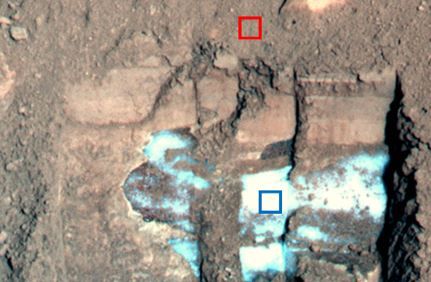Dust on Mars gets everywhere – including on top of ice deposited during one of Mars’ previous ice ages. Just how that dust affects the ice is still up for some debate. Adding to that debate, a recent paper by researchers at Arizona State University and the University of Washington has laid out a map between the dust content of a glacier and the brightness of its ice.
As with many climate-related interactions, the seemingly simple interface between the ice and dust is much more complicated than it appears. The team used pictures from the Phoenix Mars Lander and the Mars Reconnaissance Orbiter to build a model that would predict how bright snow and ice would be here on Earth. They then flipped that approach to estimate how the dust on Mars affects the brightness of ice deposits on the planet.
It turns out a lot of ice on Mars is covered in dust, and the color of that dust makes a huge difference to the ice it covers. Darker dust strains would attract more heat, making it more likely the ice it covers would melt. Alternatively, ice that is not covered by dust is reflective, making it less likely to melt in the much weaker Martian sun.
If any ice does melt due to the increased solar radiation it receives, the dust piled on top of it also makes the resulting water less likely to evaporate away into the Martian atmosphere. So the Martian dust itself might play an important part in any Martian hydrological cycle.

Credit – Blaney et al
So far, this is simply a theory backed up by some preliminary data collected by orbital satellites and one lander. To gain further credibility, that theory will have to withstand the further scrutiny of ice samples collected off the planet’s surface in the future. Either way, if humanity ever hopes to set up a permanent base on Mars, it will be important to understand how all the complex factors present on the red planet interact to create its local environment.
Learn More:
ASU – Martian snow is dusty, could potentially melt, new study shows
AGU – Spectral Albedo of Dusty Martian H2O Snow and Ice
First Post – RESEARCHERS FIND MARS’ SNOW HAS DUST MIXED INTO IT, COULD MELT INTO WATER
UT – Here’s the Best Place for Explorers to Harvest Martian Ice
Lead Image:
Snow (white segments) covered by dust, which was then scraped off by the Phoenix lander.
Credit – NASA / JPL-Caltech / University of Arizona / Texas A&M

